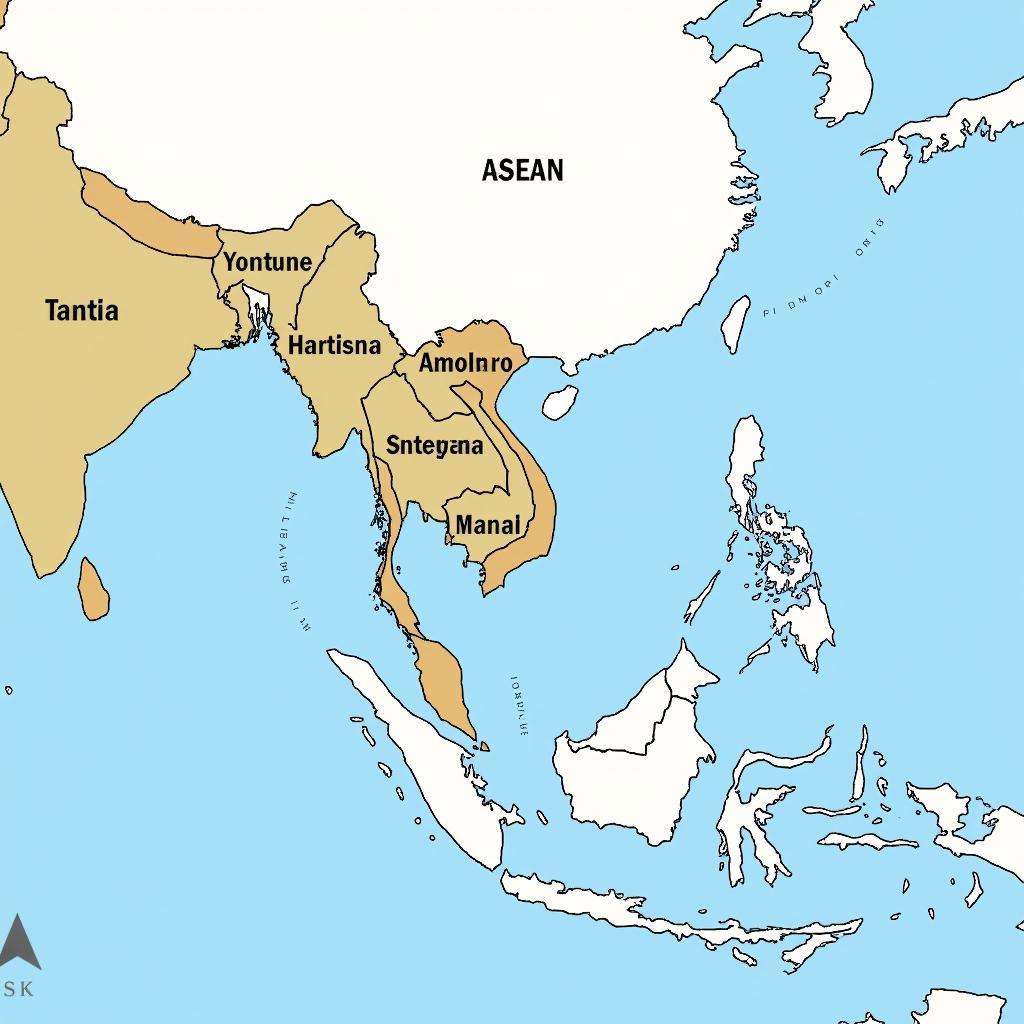Southeast Asia, a vibrant tapestry of cultures, economies, and landscapes, is home to the Association of Southeast Asian Nations (ASEAN). Understanding the ASEAN definition geography is crucial to grasping the complexities and opportunities this dynamic region presents. This involves not only locating ASEAN on a map but also exploring the diverse physical and human geographies that shape its identity.
Defining ASEAN: More Than Just Lines on a Map
 Map of ASEAN countries in Southeast Asia
Map of ASEAN countries in Southeast Asia
ASEAN’s geographical definition encompasses the ten member states of Brunei, Cambodia, Indonesia, Laos, Malaysia, Myanmar, the Philippines, Singapore, Thailand, and Vietnam. This diverse group occupies a strategically important location, bridging the Indian and Pacific Oceans and connecting major global powers. However, ASEAN’s geography is far more complex than simply its political boundaries. It’s a region characterized by a fascinating interplay of land and sea, influenced by monsoons and volcanic activity, and home to a wealth of natural resources. This physical environment plays a significant role in shaping the region’s economies, cultures, and even political dynamics.
The Physical Landscape: A Tapestry of Diversity
From the towering peaks of the Himalayas in Myanmar to the sprawling archipelagos of Indonesia and the Philippines, ASEAN’s physical geography is incredibly diverse. This diversity contributes to the region’s rich biodiversity, as well as the challenges it faces in terms of disaster management and environmental conservation. The region is prone to earthquakes, volcanic eruptions, and tsunamis, highlighting the importance of regional cooperation in disaster preparedness and response. Furthermore, the Mekong River, one of the world’s longest rivers, plays a vital role in the livelihoods of millions in mainland Southeast Asia, underscoring the need for sustainable water management practices.
Human Geography: A Melting Pot of Cultures and Economies
ASEAN’s human geography is equally compelling. The region is home to a vast array of ethnic groups, languages, and religions, contributing to a rich cultural tapestry. This cultural diversity is a source of strength, fostering creativity and innovation, but also presents challenges in terms of social cohesion and national identity. ASEAN’s demographics are also marked by a youthful population, presenting both opportunities and challenges for economic development. The region’s rapidly growing cities are hubs of economic activity, but also face issues related to urbanization, such as traffic congestion, pollution, and inequality.
Economic Integration: Towards a Shared Future
asean ap human geography definition provides further context for understanding the region’s demographic and economic dynamics. ASEAN’s economic landscape is undergoing rapid transformation. The establishment of the ASEAN Economic Community (AEC) aims to create a single market and production base, promoting greater economic integration and competitiveness. This involves reducing trade barriers, facilitating the free flow of goods, services, investment, and skilled labor, and strengthening regional connectivity. The diverse range of economies within ASEAN, from highly developed Singapore to emerging economies like Vietnam, presents both opportunities and challenges for achieving this goal.
Navigating Geopolitical Complexities
ASEAN’s geographical location places it at the center of complex geopolitical dynamics. The South China Sea dispute, involving several ASEAN member states and China, is a major point of contention. asean and south china sea conflict explores the intricate details of this ongoing issue. Maintaining peace and stability in the region is crucial for ASEAN’s continued development. The region also plays an increasingly important role in global affairs, promoting dialogue and cooperation on issues ranging from climate change to counterterrorism. The asean center of energy jakarta exemplifies the region’s commitment to addressing shared challenges through collaborative initiatives.
Conclusion: ASEAN’s Geographic Significance
Understanding the ASEAN definition geography is essential for appreciating the region’s complexity and potential. Its unique combination of physical and human geography shapes its economic, political, and cultural landscape. By fostering regional cooperation and addressing shared challenges, ASEAN can continue to thrive and play a leading role in the global community.
FAQ
- What are the 10 member states of ASEAN?
- What are the main geographical features of Southeast Asia?
- What are the major economic activities in ASEAN?
- What are the key challenges facing ASEAN?
- How does ASEAN’s geography influence its political dynamics?
- What is the significance of the Mekong River to the region?
- How does ASEAN promote regional cooperation?
For those interested in lighter fare, you might enjoy asea crossword. We also offer diverse content, such as asean babes.
Need support? Contact us 24/7: Phone: 0369020373, Email: [email protected], or visit us at Thon Ngoc Lien, Hiep Hoa, Bac Giang, Vietnam.

